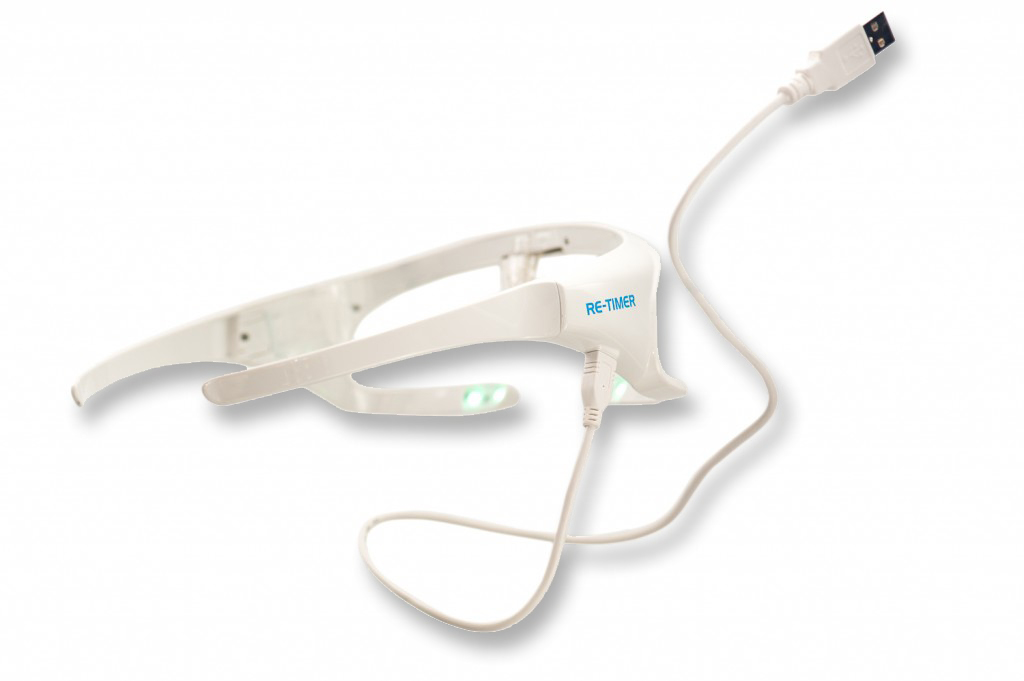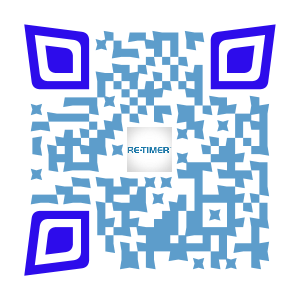澳大利亞弗林德斯大學:調整人體生理時鐘與治療失眠的關係
This page presents an overview of the use of light therapy for treating a range of disorders such as insomnia, winter depression, and jet lag arising from mis-timing of the 'Body Clock'.
If you are only interested in the availablility of the LED light glasses please email Re-Timer TW.
Visual light stimulation for re-setting the body clock
The Body Clock times the 'ups and downs' of our biology and behaviour across the 24 hour day. It determines when we feel sleepy and when we are alert. When body temperature and metabolic rate are 'up' or at their highest, for most people at about 6-8 pm in the early evening, then muscular strength, speed of reactions and alertness are at their highest for the whole day. Likewise, most people have their 'down' or lowest levels of body temperature, metabolism, speed, and strength at around 4-5 am in the morning. This time is also when we are sleepiest and most likely to fall asleep quickly. This high sleepiness tendency in the early morning can probably account for the high death rate in single vehicle accidents and other notable accidents due to 'human error', in these cases a result of falling asleep in dangerous situations.

Night shift work
The strength of our body clock on our sleepiness/alertness tendency can also be demonstrated in night shift work when it is very difficult to remain awake during the hours of 3-6 am. In addition the night shift worker finds it difficult to sleep during the day because the body clock is programmed for wakefulness in the day time.
Jet lag
If we fly overseas across many time zones, we can experience difficulty staying awake during the day and sleeping soundly at night. Why does this happen after crossing time zones? The jet traveller’s body clock remains set for Australian time which may be up to 12 hours different to their destination. The body clock would still be saying it is time to sleep during what is Australia’s night time. The result is an overwhelming desire to sleep during the daytime of the overseas destination. And across the night time of the overseas destination the body clock would be saying it is time to be awake. This results in broken and unrefreshing night time sleep. These effects of this body clock mis-timing we call 'jet lag'. It may take several days or weeks to get over the jet lag. 'Getting over it' is the process of re-timing our body clock to link in with the new destination day/night time.
Insomnia
There are common types of insomnia which also are caused by mis-timing of the body clock. Sleep onset insomnia is the chronic difficulty in getting to sleep at the desired time, but sleeping well once asleep and then having difficulty arising in the morning in time for daytime responsibilities. These people have body clocks timed too late or are delayed compared to normal sleepers. The delayed body clock means that the alert period of the body clock may be timed as late as 10 pm to 1 am and will make it difficult to get to sleep before 1 am. If it is then necessary to awake at 7 am then there will be insufficient time to get a full night’s sleep resulting in daytime tiredness.
Another type of insomnia, more common in older people, is early morning awakening insomnia. These people fall asleep easily early in the night but then awaken early in the morning without sufficient total sleep. Their body clocks are timed too early signalling that it is time for daytime wakefulness before they have had sufficient sleep.
Winter depression
Probably the greatest use of bright light therapy is for the treatment of winter depression, especially in very northern countries which have little sunlight in the winter months. These sufferers appear to have delayed body clocks and benefit most from morning light therapy.
Bright light therapy
Research shows that bright light visual stimulation (light which enters the eyes), can change the timing of the body clock and its timing of sleep or awakening signals to the body. Thus, bright light therapy has been used to treat the range of disorders caused by a mis-timed body clock including shift work, jet lag, sleep onset and early morning insomnia mentioned above as well as winter depression (Seasonal Affective Disorder, SAD).
In the case of night shift work, bright light stimulation in the early morning (12 midnight to 4 am) can delay the body clock up to 6 hours moving the sleepy period from early morning to the middle of the day. Workers are then alert on the night shift and can sleep well during the day.
People eventually overcome jet lag effects but may take weeks to do so. You can get over jet lag more quickly by getting daytime exposure to bright light (getting outside into the sunlight). This re-times the body clock to enable daytime alertness and good sleep at night time. In the case of flying westward, as from Australia to Europe, to get over the jet lag in Europe your body clock needs to be delayed. This is what was needed in the night shift worker and accomplished by light during the early morning hours in Australia. However, in Europe these same hours with respect to your body clock will be late afternoon. Therefore, getting light stimulation from the early afternoon for as long as sunlight is available will help you get over jet lag more quickly. If it is summertime in Europe with sunshine until late, then getting outdoors for the rest of the day from 3 pm onwards will be very helpful. However, if you need to stay indoors or if it is the cold and dark weather of winter, then the assistance of the LED light glasses can produce a similar beneficial effects to that of sunlight.
For sleep onset insomniacs who have delayed body clocks we have shown that treatment with bright light stimulation in the morning (7-9 am) is helpful. For early morning awakening insomnia in which the body clock is timed too early, we have shown that evening bright light stimulation is beneficial. It delays their rhythms, delays their final awakening, and increases their total amount of sleep.
Bright light therapy at present
The present most common mode of delivering bright light is with the use of manufactured light boxes. These devices have the important market advantage in having been extensively used in circadian rhythm research with proven ability to affect the timing of circadian rhythms. However, these devices have four handicaps.
1.They have to be large (60cm X 50cm X 20cm) in order to contain sufficient high intensity fluorescent tubes to provide 3,000 - 10,000 lux illumination when placed approximately a metre from the user.
2.They are not readily transportable because of their weight and need for mains power.
3.The high intensity and somewhat aversive light source is fixed in space and can be easily avoided with change of direction of gaze. Compliance to directions of use may be poor and inadequate for therapeutic effect.
4.They are expensive to purchase (US$300 - US$500).
Flinders LED light glasses project
We have fully evaluated devices with light emitting diodes (LEDs) mounted on spectacle glasses for their body clock re-setting capacity. The glasses mounted LEDs provide light stimulation of equivalent intensity to light boxes for 20 hours operation on one small, inexpensive 9 volt battery. They are easily portable and can provide the possible therapeutic effects while the user is mobile or in situations where domestic power is unavailable such as a passenger in a moving vehicle or jet plane.. Because of their small size and relatively inexpensive components, the LED glasses will be less expensive than the presently marketed light boxes. They suffer none of the handicaps of light boxes listed above. One of their main advantages is that our research has confirmed their body clock re-setting effects which are the basis of treatment for all of the above conditions.
Using coloured LEDs as light sources also made it easy to test different colours for their capacity to re-time the body clock. This has been the focus of our research over the past three years. To summarise, the blue end of the visible spectrum contains the wavelengths of benefit for body clock re-timing. The scientific results show some effect starting about 530nm (green) and increasing in effect with shorter wavelengths reaching a maximum at about 450-510 nm (blue and blue/green). Our LED light glasses use this most effective colour range for re-timing the body clock.
At present the LED glasses are still experimental devices. They are not yet commercially available. Flinders Partners is heading this commercialisaton project. Their information can be found here.
Book for non-drug insomnia treatment
A useful small book for the understanding of sleep and management of insomnia by Dr Helen Wright and Professor Leon Lack can be ordered on-line.
More---http://www.flinders.edu.au/sabs/psychology/research/labs/sleep/bas.cfm

